 Light Submersibles 1932-1945: 49 built, Unity class, Group II, III
Light Submersibles 1932-1945: 49 built, Unity class, Group II, III
Group I: HMS Undine, Unity, Ursula
WW2 British Submersibles:
X1 | Odin | Parthian | Rainbow | Thames | Swordfish | Porpoise/Grampus | Shark | U class | T class | S class | U class 1940 SH | P611 class | V class (U 1941/42 LH) | X-Craft | A classThe U-class submarines, also known as Undine-class, were a group of diesel-electric submarines built for the Royal Navy during the 1930s and saw extensive service throughout World War II. They were relatively small and designed for operations in the North Sea and Mediterranean, where their compact size allowed them to manoeuvre more easily in shallower waters. The U-class submarines were known for their reliability and versatility and were particularly effective in anti-submarine warfare and reconnaissance missions.
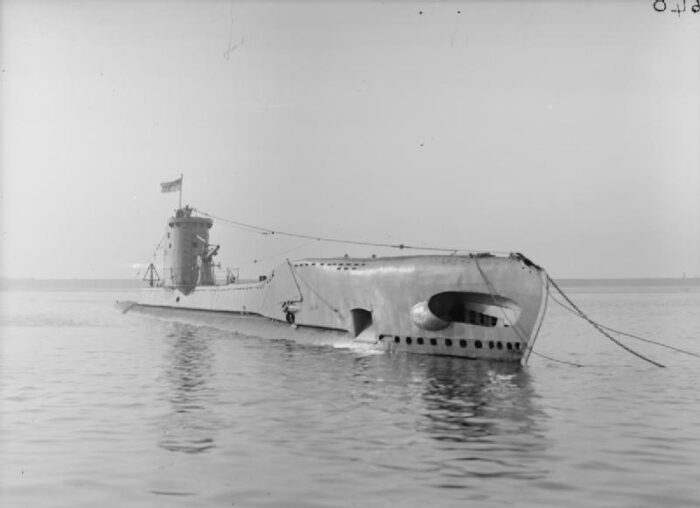
The U-class submarines were initially built as small, experimental submarines intended for training but proved to be quite effective operationally. This led to their eventual mass production and their use in active combat. The class went through several iterations, with each group improving upon the design of the previous one.
Specifications (varied slightly by group)
Displacement was Approximately 545 tons surfaced, 740 tons submerged, length About 58 meters (190 feet), powered by a Diesel-electric system, with two diesel engines driving electric motors for a to speed of 11.25 knots surfaced, 9 knots submerged and range of 4,500 nautical miles at 10 knots surfaced. Operational depth was around 60–90 meters, with some later boats capable of deeper dives
As far as armament went they had four 21-inch torpedo tubes in the bow, capable of carrying up to 8 torpedoes. Later versions were fitted with a 3-inch deck gun for additional surface attack capability and certain variants could also carry and deploy mines.
The U-class submarines saw extensive combat service during WWII, particularly in the Mediterranean and North Atlantic, where they conducted a variety of missions, including classic Anti-Submarine Warfare missions against enemy submarines, particularly in the North Sea. They were used for coastal Patrols, performing reconnaissance, patrolling close to enemy coastlines. They were used also for Convoy Protection by patrolling shipping lanes and were used for Special Operations, supporting covert missions and transporting Allied commandos behind enemy lines or VIPs in occupied territories.
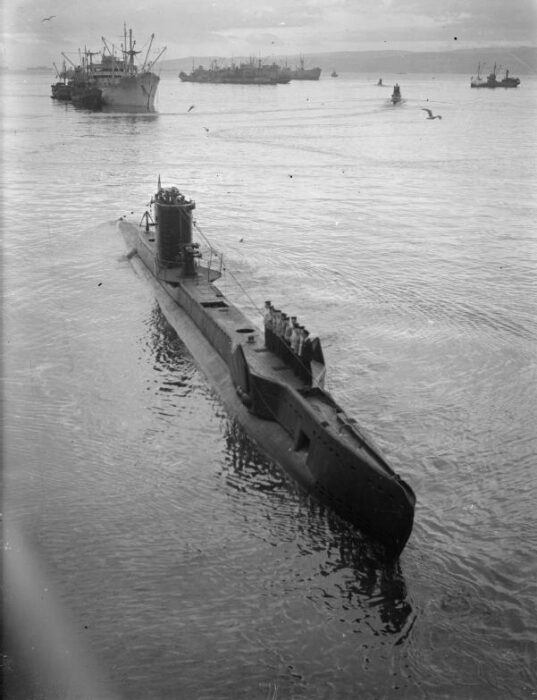
HMS Ultimatum, of Group III, Batch 1940
These submarines were particularly effective in the Mediterranean, where their smaller size and shallow draft allowed them to operate close to enemy-held shores and in narrow straits, such as the Strait of Gibraltar. Their contributions were significant, as they helped contain the threat of Axis supply lines and contributed to the overall success of Allied naval operations.
A total of 49 U-class submarines were completed, with 20 being lost in action. Despite their limitations, U-class submarines were seen as a success due to their adaptability and combat effectiveness. Some submarines were transferred to other navies, including the Royal Netherlands Navy, Polish Navy, and Free French Naval Forces.
The U-class set the foundation for later British submarine designs and contributed valuable lessons in diesel-electric submarine warfare. They were succeeded by V-class, a final refinement of the U-class with 34 ordered, 21 built by Vickers under the 1941-42 War Emergency Programmes and the remainder cancelled. The hull was further lengthened to avoid vibrations and “singing propellers” issues whereas the bows were more streamlined. Hull Welding was introduced on thicker steel for the pressure hull, so they could dive down to 300 ft (91 m). None V-class were lost in action and they served for may years in the coldwar or were sold.
Development
The Royal Navy limited itself to 52,700 long tons (53,500 t) of submarines under the London Naval Treaty of 1930, a tonnage limit that favored smaller submarines. This was comounded by numerous reports of earlier large submarines trials showing they were slower to dive, handled poorly and were easy to see and hear. The First World War H-class submarines still around for training in anti-submarine warfare arrived at the end of their career, and this justified replacement in the eyes of the parliament. The Rear-Admiral Submarines, Noel Laurence wanted to simply replaced these with the same type of simple and inexpensive training boats but with enough torpedoes to found usefulness by making short-range patrols in wartime.
In March 1934 he approved the future U class specifications. He called for a “Small, Simple, Submarine, for Anti-Submarine Training (…).” The first three Unity-class boats were eventually ordered once finance was obtained, as HMS Undine, Unity and Ursula on 5 November 1936, from Vickers-Armstrongs, Barrow-in-Furness. The 1926 Hopwood Committee confirmed that names were preferrable to numbers due to crew morale and command and control, but that these names would begin with the same letter in the alphabet. As the plans and detailed blueprints were approved, the new U class would appear as the smallest built since the last war.
Predecessors: The H class

H4 at Brindisi in 1916
The British H-class submarines were Holland 602 types, constructed between 1915 and 1919 and becoming Britain’s largest class of submarine before WW2. They were designed and built in response to minelaying U-Boats and also to perform similar operations in German waters or to hunt German submarines in British waters at large.
They were considered as cramped and many lacked a deck gun but these remained popular amongst submariners. In addition many were sent to the Adriatic but most arrived late and saw little service and further batches saw no service at all, but on the interwar. They still sank U-51 and UB-52, loosing four of their own.
Post-war, many were retained for training purposes, four more lost in accidents in the 1920s. They were obsolete in 1939 and so they served in training and for coastal patrol, mitigating the heavy RN submarine losses in the early years. Two were sunk by the Germans. Canada also built some, which were equipped with Fessenden transducers.
The U class were completely different beasts from the S-class, desptite the fact the latter were also light submersibles. They found their origin in the Shark class, with more made in the 1941 programme, 1942 and 1943 programmes. They had a much longer range and much heavier tonnage of 810-990t for the latter series versus 500/700 tonnes for the U class.
Biography: Noel Laurence
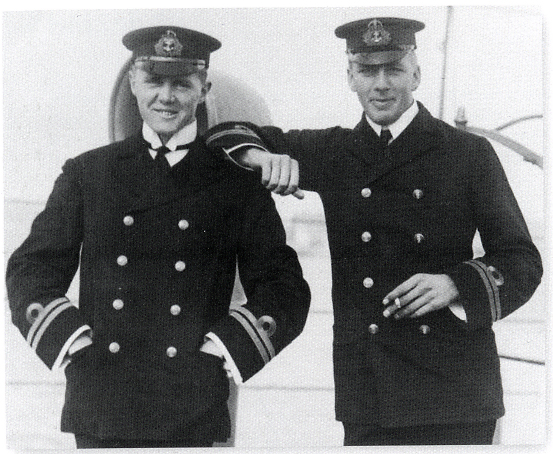
Admiral Sir Noel Frank Laurence KCB DSO* (27 December 1882 – 26 January 1970) was a notable Royal Navy submarine commander in the First World War and became in the interwar the submarine branch head of staff. Born in 1882 in Kent, her joined the RN in 1899 and by 1904 he became lieutenant and submarine specialist. In 1914, he commanded HMS E1 in the Baltic Sea and worked with the Russians attacking Riga in 1915 and damaged the battlecruiser SMS Moltke. Her was awarded a DSO and the Order of St. George, Order of St Vladimir from the Russians. Her commanded J1 which torpedoed two German battleships near Jutland and had more subs in 1917 being awarded by more bars and earning the Legion of Honour by the French.
To precious to continue as sub captain he ended in commanded of HMS Bonaventure, submarine depot ship and base, now directing his own submarine flotilla. He became Commodore of Devonport Naval Barracks in 1930, Rear-Admiral, Submarines in 1932 and Vice-Admiral Aircraft Carriers in 1936, Admiral Commanding Reserves in 1938 but moved to the Ministry of Aircraft Production as the naval representative and retired in 1943. In 1938 she was made Knight Commander of the Order of the Bath and promoted admiral on 1 August 1940. He passed away in 1970 in Surrey.
Unity class boats
This class, laid down in 1937 and completed in 1938, were intended as replacements of the ‘H’ class for training and local patrols. They were distinguished by electric drive when surfaced, the main motors being driven from the dieselpowered generators, and were of single-hull type with an operational depth limit of 200ft. The external TT were in the bows and resulted in a bluff form which was not very satisfactory in a seaway.
The UNDINE class (also called “U” class prewar programme was designed at first for a 500t displacemnt, which looked unrealistic, and was later ported to 540t standard. She displaced 630t/730t on “normal” and fully loaded displacement for hull just 191 feet long and to be powered by Paxman-Ricardo diesels coiupled with Vickers electric motors. The former actually developed less than the latter and both surfaced and submerged speeds were about the same between 11-10kts. On trials Undine made 12.45kts surfaced and 8.58kts submerged.
Range was an issue as they only carried 38t of oil, in two 19 tonnes fuel tanks. The initial armament was to be only in the bow and initially of six tubes plus 10 torpedoes including those in the tubes already, leaving 4 spares. It was impossible to fit all six in the pressure hull so two remainder were placed in the outer hull and not reloadable. They were also given a 3 inches/20cwt deck gun from the start. Ursula had only 8 torpedoes to compensate for the weight of the 3in gun, which only she carried, and she could subsequently carry 6 M2 mines as an alternative. The crew amounted to just 27 compared to 48 for an S-class boat (almost double) and to 61 on a T-class (2.5 times larger).
This was due a clever way to manage ergonomics so that some crew members could take on several roles. Still, in their tiny pressure hull they felt extremely cramped. Yet, they appeared in general to be very reliable and agile despite lacking speed and range.
In all three boats were made, UNDINE (Vickers, Armstrong-Barrow, launched 5.10.1937), UNITY (16.2.1938) and URSULA (16.2.1938) the only one to survive the war, discarded in 1950. She was loaned to USSR as B4 from 1944 to 1949 but was allegedly handed over in such a poor state that she was no use to the RN and quickly decommissioned. See later for the historical records of all three.
Design of the class
Hull and general design
The U class were the smallest British submarines built since the D class back in 1908. They displaced 540 long tons (550 t) standard as well as 630 long tons (640 t) full load but surfaced and 730 tons submerged so a 100t buoyancy difference. The weight of a submarine under water needed to always equal its buoyancy, with extra weight compensated for by removing an equal amount of ballast near the keel and it was linked to the density of the water around, from fresh to highly saline.
They were also moderately compact at 191 ft (58 m) long overall for a beam of 16 ft 1 in (4.90 m) and a draught of 15 ft 2 in (4.62 m). To compare the 1908 D-class measured only 50.2 meters long but were beamier at 6.2m, with a 3.5 m draught. Theor conning tower was a simple bathtub style
The U-class boats had a hull of riveted steel, 0.5 inches (13 mm) thick to be able to dive down to 200 feet (61 m) while having the fuel tanks and ballast tanks inside rather than outside the outer hull. Still they were of a partial double hull type. The superstructure and conning tower were built with free-flooding holes as well as storage spaces for cables, anchors and sundry items which was found handy in service. No spare space was left inoccupied. The pressure hull was divided into five bulkheads. The main acess was from the conning tower with an hatch in the torpedo-stowage compartment. However the engine room had drop-down canvas trunks usabled in emergencies. Lessons of the losses of the H class were well retained.
After closing all water-tight doors, the trunks were lowered, connected to the deck. The hatch was opened slightly until air–water pressure was equal. The crew breathing trapped air until escaping. Each crewman had a Davis Submerged Escape Apparatus of nose-clip and mouthpiece connected to the short duration oxygen bag, only there for the pressure balance and rise up. The first man in trunking opened the hatch and left the boat, then the others in turn. Escape from the conning tower was saw two entering the tower and closing the lower hatch, then opening the upper one, flood this before leaving. So at least now there were ways to two escape.
Among interesting equipments were their 200 mm bifocal periscope fitted with low and high magnification and a second 6 inches (150 mm) low magnification periscope for attack only, more discreete. The periscopes could rise 12 ft (3.7 m) but they had a very shallow periscope depth and were easily spotted from the air in the Mediterranean.
Powerplant
These small boats were powered by two 400 hp (300 kW) Paxman diesel-electric engines. Each had an outout of 615 bhp (459 kW). Tis was completed by two Vickers electric motors rated for 825 shp (615 kW). The diesels totalled 1230 bhp, enough for a surface speed of 11.25 knots (20.84 km/h; 12.95 mph) and the two electric motors a submerged speed of 10 knots (19 km/h; 12 mph). The diesels drive directly the propellers via generators also charging the battery composed of 112 cells under the control room/crew accommodation. There was a small hatch for checking these. The propellers were the object of great care, made not to perform best on the surface but rather submerged in order to reduce propeller noise. However destpite of this, these “singing propellers” remained a problem for the class. They had a fuel capacity of 38 long tons, enough for a range of 3,800 nmi (7,000 km; 4,400 mi) at 10 knots (19 km/h; 12 mph) surfaced, 120 nmi (220 km; 140 mi) submerged at 2 knots (3.7 km/h; 2.3 mph). She needed to surface to recharge her battery. In 1944 however some of the wartime U-class tested dummy snorkels solely for ASW training. For quick diving the U class had six ordinary ballast tanks and a special quick-diving “Q tank”. These ballast tanks as well as the hydroplanes and rudder were all hydraulically operated. The forward hydroplanes were placed high on the bow, folding upwards for docking.
Armament
As seen above the small pressure hull was too constrained to fit more than four tubes. Still, specs called for six, so the two extra ones were relocated to the outer hull, and so considered “external”. This was done also for the T class. These four internal bow torpedo tubes could be reloaded underway. Each had a single spare torpedo, the other being already present in tube when loaded at port. The two external tubes were only reloadable in port. They were located in a specific bulged housing forward, creating also a “forecastle” of sorts. Between the internal and external tubes this amounted to ten. The prospect of having two stern tubes was dropped early on due to the lack of space and trimming complications.
Before the war, the first second group boats, HMS Unique, Upholder, Upright and Utmost only had eight torpedoes for weight reasons, and kept their external tubes, but later groups dispensed of these, as bulge generated a large bow wave. Dive stability at periscope depth was problematic and trimming even more sensible. These boats had a shallow 12 ft (3.7 m) persicopic depth, which conducted captains to also to discard the two external tubes. This loss was felt fully justified in operations. Plus when firing these two external tube torpedoes, sudden loss completely break stability and trim, making them to porpoise, break the surface under enemy guns. It was already feared in 1938 and so the Group two boats of the War Supplementary Emergency Programme had the bulg but not the external torpedo tubes already. Group III boats were the first with a straight bow.
21 inches Mark VIII**
The Mark VIII were the first burner-cycle torpedo in service and the most common became the VIII**, with 3,732 fired by September 1944, 56.4% total of those made. It was exported and maintained in service as late ass 1983. A truly fast and dependable model. When correctly used, itw as a sure kill in stark contrast to the US Mark 14. The model suggested below was standard when completed. They were designed betrween 1925 and 1927, and were mass produced for all British subs from the O class. They had a negative buoyancy of 804 lbs. (365 kg).
⚙ specifications Whitehead Mark 8 double star |
|
| Weight | 3,452 lbs. (1,566 kg) |
| Dimensions | 21 ft 7 in (6.579 m) |
| Propulsion | Burner-cycle, 322 hp @ 45 knots |
| Range/speed setting | 5,000 yards (4,570 m)/45.5 knots or 7,000 yards (6,400 m)/41 knots |
| Warhead | 722 lbs. (327 kg) TNT, WW2 805 lbs. (365 kg) Torpex |
| Guidance | Stright course |
3 in (76 mm) QF 20 cwt
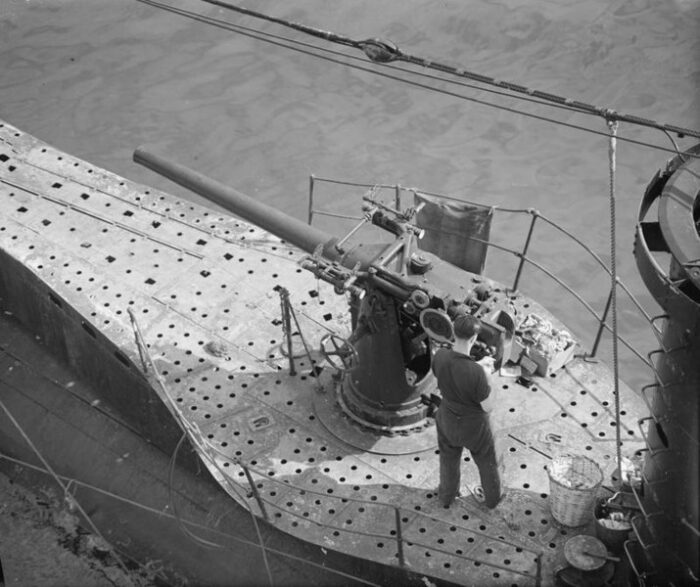
HMS Ursula and most of the U class built afterwards carried a 3 in (76 mm) Mark V deck gun. It was not protected by the conning tower and unshielded. Ther crew was completely exposed. To compensate for its weight the ten torpedoes carried on paper was reduced to eight. This deck gun was originally a dual purpose or AA model, but the deck gun mount had a more limited elevation than surface ship’s 90°. This gun was shared by the S-class, U-class and V-class submarines. Approximate Barrel Life was 1,250 rounds.
⚙ specifications 3 in (76 mm) QF 20 cwt Mark V |
|
| Weight | 2,240 lb (1,020 kg), gun and breech |
| Barrel length | 11 ft 4 in (3.45 m) (45 cal) |
| Elevation/Traverse | CPV mount, +40°, 300° |
| Loading system | Semi-automatic sliding-block, 13 in (33 cm) recoil |
| Muzzle velocity | 2,350 feet per second (720 m/s) |
| Range | 10,900 yards (9,970 m), 13k yds max |
| Guidance | Optical |
| Crew | 6 |
| Round | Fixed QF HE 76.2 × 420 mm R, 31 pounds (14 kg) |
| Rate of Fire | 16–18 rpm |
Sensors
The U class had Hydrophones fitted on each side near the bow and facing outwards. There was an extra one on the conning tower, facing aft to cover all angles. Next, an Asdic Type 129 was installed forward of the keel (from 1937). For communication the U class had two wireless aerials plus a jumping aerial on the conning tower usable to detect low frequency signals at periscope depth. The also had a WT mast raised above the water spread for conventional wireless signals.

Group I profile general appearance, HMS Unity.

Rendition of HMS Ursula, Group I
⚙ specifications Undine class |
|
| Displacement | 540 long tons (550 t) standard, 630 long tons (640 t) FL surfaced, 730 tons submerged |
| Dimensions | 191 ft x 16 ft 1 in x 15 ft 2 in (58 x 4.90 x 4.62 m) |
| Propulsion | 2 shaft Paxman Ricardo diesels, 2 Vickers electric motors 615 hp/825 hp |
| Speed | 11.25 knots surfaced, 10 knots submerged |
| Range | 4,500 nmi at 11 kn surfaced |
| Armament | 6× 21 in (533 mm) TTs (bow), 10 torpedoes, QF 3 inch 20 cwt 3 in gun |
| Test Depht | 58 meters (190 feet) |
| Sensors | Hydrophones |
| Crew | 27 |
Career of the U class
 HMS Undine (N48)
HMS Undine (N48)
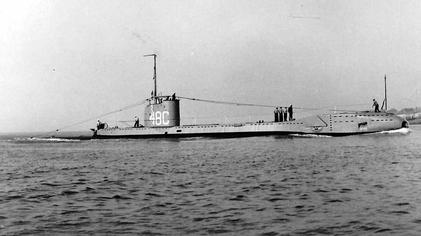
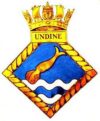 Undine was built by Vickers Amstrong, Barrow-in-Furness. She was laid down on 19 February 1937 and commissioned on 21 August 1938, pennant N48. In 1939 she was part of the 6th Submarine Flotilla. From 26–29 August 1939, she was moved to her patrol bases at Dundee and Blyth. On her fourth war patrol in January 1940 her sonar failed. At 09:40 on the 7th she could not detect incoming German auxiliary minesweepers M-1201, M-1204 and M-1207. She spotted them, tried to sink the leading vessel, but they counter attacked, forced her to dive to 50 feet (15 m). She waited for five minutes with no more depht charging before she raising her periscope and the spotted, attacked, badly damaged by an explosion, abandon ship being ordered and she was scuttled.
Undine was built by Vickers Amstrong, Barrow-in-Furness. She was laid down on 19 February 1937 and commissioned on 21 August 1938, pennant N48. In 1939 she was part of the 6th Submarine Flotilla. From 26–29 August 1939, she was moved to her patrol bases at Dundee and Blyth. On her fourth war patrol in January 1940 her sonar failed. At 09:40 on the 7th she could not detect incoming German auxiliary minesweepers M-1201, M-1204 and M-1207. She spotted them, tried to sink the leading vessel, but they counter attacked, forced her to dive to 50 feet (15 m). She waited for five minutes with no more depht charging before she raising her periscope and the spotted, attacked, badly damaged by an explosion, abandon ship being ordered and she was scuttled.
 HMS Unity (N66)
HMS Unity (N66)
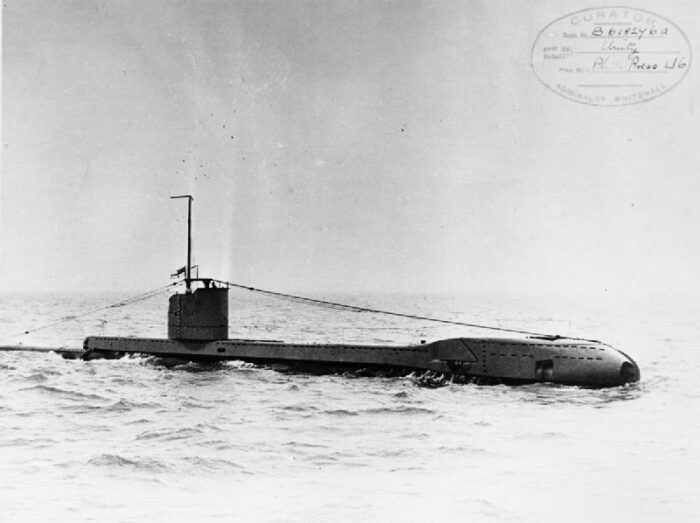
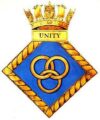 Unity was built by Vickers Armstrong, Barrow-in-Furness. She was laid down on 19 February 1937 and was commissioned on 5 October 1938. She was part of the 6th Submarine Flotilla as all three sisters of the Unity clas, Ist group. From 26–29 August 1939 she moved to Dundee and Blyth, patrolling in home waters, North Sea, spotting and attacking but missing U-2. She rescued men from the Dutch fishing vessel Protinus, 25 March 1940. On 11 April 1940 she was spotted by U-5 (another IIa coastal model) commanded by Kapitänleutnant Lehmann. He fired a G7a (T1) torpedo and the latter spotted the bubble trail making a crash dive. U-5 followed and launched another underwater but this time with a G7e (T2) electric torpedo until contact was lost. Both departed their way.
Unity was built by Vickers Armstrong, Barrow-in-Furness. She was laid down on 19 February 1937 and was commissioned on 5 October 1938. She was part of the 6th Submarine Flotilla as all three sisters of the Unity clas, Ist group. From 26–29 August 1939 she moved to Dundee and Blyth, patrolling in home waters, North Sea, spotting and attacking but missing U-2. She rescued men from the Dutch fishing vessel Protinus, 25 March 1940. On 11 April 1940 she was spotted by U-5 (another IIa coastal model) commanded by Kapitänleutnant Lehmann. He fired a G7a (T1) torpedo and the latter spotted the bubble trail making a crash dive. U-5 followed and launched another underwater but this time with a G7e (T2) electric torpedo until contact was lost. Both departed their way.
Leaving Blyth on 29 April 1940 for a sortie off Norway, she collided with the Norwegian ship Atle Jarl. Completely rolled over and badly damaged, she had rushing water leaks and sank in five minutes, however all but two survived: Lieutenant John Low and able Seaman Henry Miller remaining behind to lock the flooded control room. They shipmates could escape. The wreck was located again between 48 and 55 m (157 and 180 ft) off the Farne Islands.
 HMS Ursula (N59)
HMS Ursula (N59)

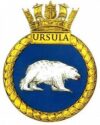
Ursula was built by Vickers Armstrong like her sisters, laid down on 19 February 1937, commissioned on 20 December 1938 and entering the 6th Submarine Flotilla. On 9 September 1939, she spotted and attacked U-35 but missed. This was the first RN sub attack of the war. On 14 December she was patrolling of the Elbe estuary when spotting KMS Leipzig, escorted by six destroyers. The light cruise was back to Kiel after already taking a torpedo by HMS Salmon. Ursula dived enough to remain undetected, close the distance, surfaced and launched a close-range attack and then dive again to escape. The cruise was missed but one torpedo hit the escort F9, which sank. Lt.Cdr. G.C. Phillips earned a DSO for this, being promoted. Still in the North Sea, she spotted and sank the German merchant Heddernheim.
Next she was ordered to the Mediterranean and there, sank the Italian auxiliary submarine chaser V 135, German merchants Sainte Marguerite II, Odysseus, badly damaged the Italian merchant Sabbia. However she was almost sunk by the escort and notably the Italian torpedo boat Generale Carlo Montanari. She also sank the trnasport Brook, Tilly L.M. Russ, Vulcania and even U-73. She badly damaged the tanker Beppe, towed to Tripoli and beached.
Lt Cdr Philips in a permission before heading to the Med, contacted a tailor to make him a specific “Ursula” suit which he wore each time he made a successful patrol. He also wanted better suits for its submariners, as the crew was dissatisfied with the conventional oilskins. Her designed himself a special clothing more suitable and navigating officer, Lt. Lakin proposed his one-piece waxed cotton motorcycling suit from Barbour, adapted and made into jacket and trousers with hood. This became soon a sensatio and the company sold it as the standard watch-keeping clothing for RN submarines.
On 26 June 1944 her RN career ended as she was transferred on loan to the Soviet Union, renamed V-4 “Soviet Svanetia” and had a new commander Yaroslav Iosseliani. On 20 October 1944 she operated from Murmansk and sank the German submarine chaser UJ-1219. She was returned in early 1950, scrapped at Grangemouth in May. She was one of the most successful U class subs.
U class Group II
Early Group II
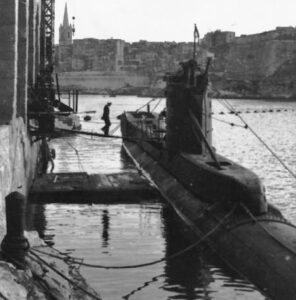 The experience gained with the U-class helped forging ahead with an incrementally improved Group 2 boats, as part of the War Supplementary Emergency Programme. It consisted of a first batch of twelve submarines of a similar design to the original three, so basically simple repeats. However for these the external torpedo tubes were omitted and and they had a redesigned stern to reduce cavitation. Some also inaugurated a new bow shape to reduce the bow wave. Their hydroplanes were also reshaped and enlarged for better submerged handling. Due to deck gun shortages, they were equipped when completed by WWI vintage 12-pounder. HMS Unbeaten and Unique only were completed with the modern 3-inch gun as intended. These boats as ordered in 1940 and 1941 had the new 3-inch gun and more fuel. They all came from Vickers at Barrow-in-Furness.
The experience gained with the U-class helped forging ahead with an incrementally improved Group 2 boats, as part of the War Supplementary Emergency Programme. It consisted of a first batch of twelve submarines of a similar design to the original three, so basically simple repeats. However for these the external torpedo tubes were omitted and and they had a redesigned stern to reduce cavitation. Some also inaugurated a new bow shape to reduce the bow wave. Their hydroplanes were also reshaped and enlarged for better submerged handling. Due to deck gun shortages, they were equipped when completed by WWI vintage 12-pounder. HMS Unbeaten and Unique only were completed with the modern 3-inch gun as intended. These boats as ordered in 1940 and 1941 had the new 3-inch gun and more fuel. They all came from Vickers at Barrow-in-Furness.
⚙ Group II specifications |
|
| Displacement | 630 tons surfaced, 732 tons submerged |
| Displacement 1941-42 | 658 tons surfaced, 740 tons submerged |
| Dimensions | 191 x 16 x 10ft (58 x 4.9 x 3 m) |
| Propulsion | 2x Paxman diesels 615 bhp (459 kW), 2 Vickers EM 825 hp (615 kW) |
| Speed | 11.25 kn surfaced, 9 kn submerged |
| Range | 3,800 mi (6,100 km) at 10 knots (19 km/h; 12 mph). |
| Range 1941/42 boats | 5,000 mi (8,000 km) at 10 knots (19 km/h; 12 mph) |
| Endurance | 120 mi (190 km) submerged |
| Armament | Bow 4× 21-in (533 mm) TTs (8), 6 mines, QF 12-pdr, 2-3× .303-cal MG AA |
| Sensors | Hydrophones |
| Tested Depth | 200 ft (61 m) |
| Crew | 33-36 officers and enlisted |
The MI5 also investigated the loss of HMS Vandal and Untamed in training operations. The report was kept confidential to maintain the population’s morale. Familiies received letters that their husbands and sons were “killed in action”. In June 1940, naming stopped (for a time), fearing names shortages, andthe admiralty started to use pennant numbers instead, with the prefix “P”. However there was an immediate effect of the “esprit de corps” of submariners. Upon hearing that next boats just ordered were unammed and would remain so, some captains protested on the behalf of future crews. Wether it was a remainder of WWI contempt for these “pirates”, or for practical reasons, naming ships by numbers has not been done since WWI submarines, and the latter was taken as example and explanation. The decision stuck for more than two years.
But on 4 November 1942, Prime Minister Winston Churchill questioned the policy, even though he understood some reasons of this new naming policy. The First Lord of the Admiralty replied that naming was mainly dropped to avoid confusion with destroyers names, as the “U” were alread booked in the alphabet. Numbering submarines was done in the First World War indeed, but Churchill famously declared it was better to be right (towards submariners) than consistent. Esprit de corps was thus to be maintaioned, and naming was resumed. Still, he encounters some rebuffing as the Admirakty after a delay affirmed it was difficult to find enough “U” names, which were not already taken by the S-T-U-V-W planned destroyers (1941 emergency program) and that the remainder would be named with “V”. A list was sent to Churchill on 27 December 1942. Those lost before the naming resumed kept their “P” pennants.
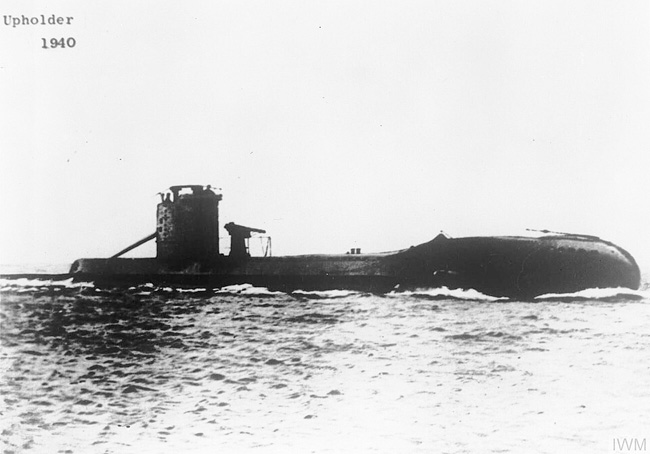
HMS Upholder (IWM). No better photo of the most successful of all British submarines in WW2
They were a few “stars” among these Group II U-class:
-Urchin was transferred to the Polish Navy as ORP Sokół, sinking 55,000 long tons (56,000 t) of Axis shipping.
-Upholder under LtCdr Malcolm Wanklyn over 16 months in the Mediterranean, 24 patrols, sank around 119,000 long tons (121,000 t) of Axis shipping, but also bagged no less than three U-boats, a destroyer, 15 merchant ships, damaged a cruiser and sank another destroyer bfore her loss in April 1942. Captain Wanklyn was awarded the Victoria Cross aso for sinking the Conte Rosso on 25 May 1941. It’s no wonder that tne name “upholder” was resurrectred for the lead boat of the last cold war diesel-electric boats. Losses in general were high, with three out of twelve surviving.
 HMS Umpire
HMS Umpire
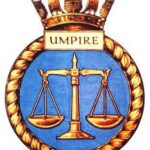 HMS Umpire was ordered on 4 September 1939 at Chatham NyD, laid down on 1 January 1940, launched on 30 December 1940 and commissioned on 10 July 1941. She was rammed accidentally and sunk by trawler Peter Hendriks on 17 July 1941, North Sea, with 22 killed. This was just 9 days after commission, with her full crew of 33. When it happened, she was en route from Chatham to join the 3rd Submarine Flotilla at Dunoon. The skipper was Lieutenant Mervyn Wingfield. From there, it was planned a working-up patrol in the North Sea before heading to the Mediterranean. After stopping overnight at Sheerness, she joined a convoy that headed North, but suffered an engine failure with a Paxman diesel, fell behind and her electric motors took over while she was still surfaced. The convoy passed a Southbound convoy around midnight and this happened 12 nautical miles (22 km) off Blakeney (Norfolk), the two passing starboard to starboard, unusual as it was usually port to port. Lights were al shut not to draw attention of reaming S-bootes.
HMS Umpire was ordered on 4 September 1939 at Chatham NyD, laid down on 1 January 1940, launched on 30 December 1940 and commissioned on 10 July 1941. She was rammed accidentally and sunk by trawler Peter Hendriks on 17 July 1941, North Sea, with 22 killed. This was just 9 days after commission, with her full crew of 33. When it happened, she was en route from Chatham to join the 3rd Submarine Flotilla at Dunoon. The skipper was Lieutenant Mervyn Wingfield. From there, it was planned a working-up patrol in the North Sea before heading to the Mediterranean. After stopping overnight at Sheerness, she joined a convoy that headed North, but suffered an engine failure with a Paxman diesel, fell behind and her electric motors took over while she was still surfaced. The convoy passed a Southbound convoy around midnight and this happened 12 nautical miles (22 km) off Blakeney (Norfolk), the two passing starboard to starboard, unusual as it was usually port to port. Lights were al shut not to draw attention of reaming S-bootes.
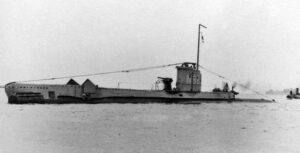 However, the armed escort trawler Peter Hendriks, part of the crossing southbound convoy accidentally struck Umpire, hidden in the dark. Having far more bulk she basically rolled over her outer hull, which was completely cut and mushed, and then cut into the pressure hull, which broke under the pressure, resulting in instant floodin, leaving no chances to the crew. She sank like a stone under 18 metres of water.
However, the armed escort trawler Peter Hendriks, part of the crossing southbound convoy accidentally struck Umpire, hidden in the dark. Having far more bulk she basically rolled over her outer hull, which was completely cut and mushed, and then cut into the pressure hull, which broke under the pressure, resulting in instant floodin, leaving no chances to the crew. She sank like a stone under 18 metres of water.
The only survivors were the four crew members on the bridge when it happened, which had the time to jump overboard. This was the skipper Wingfield, his navigator and two lookouts. However despite it was July, that north these were icy cold waters, and only Wingfield survived rapid hypothermia to be picked up by the trawler. The latter stopped immediately after the colision to investigate. Several other personnel survived simply by escaping from the sunken wreck, using the conning tower or engine room escape hatch wearing their DSEA suit. Chief ERA Killen received a British Empire Medal for leaving first to check for obstructions around the engine room hatch and returning to the engine room to assist others escaping, remained until everyone escaped. Still, 16 of the crew were lost.
 HMS Una
HMS Una
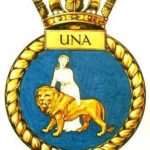 HMS Una was laid down on 4 September 1939 to Chatham Dockyard, laid down on 7 May 1940, launched on 10 June 1941 and commissioned on 27 September 1941. In the Mediterranean from early 1942, she sank the Italian tanker Lucania, Italian fishing vessel Maria Immacolata, Italian merchants Ninetto G. and Petrarca. Lucania however had been granted immunity by the Admiralty, as to be a replenishment ship for an Italian ship repatriating civilians from East Africa but Lieutenant D.S.R. Martin, was ill and had not read the Admiralty signal before departure.
HMS Una was laid down on 4 September 1939 to Chatham Dockyard, laid down on 7 May 1940, launched on 10 June 1941 and commissioned on 27 September 1941. In the Mediterranean from early 1942, she sank the Italian tanker Lucania, Italian fishing vessel Maria Immacolata, Italian merchants Ninetto G. and Petrarca. Lucania however had been granted immunity by the Admiralty, as to be a replenishment ship for an Italian ship repatriating civilians from East Africa but Lieutenant D.S.R. Martin, was ill and had not read the Admiralty signal before departure.
Una also damaged two sailing vessels and the Italian merchant Cosala, grounded, but total loss. But she also missed the merchant Brioni, the tanker Panuco and German merchant Menes. She even made an attack inside Lampedusa harbour bu missed and her torpedoes hit the rocks. In the night of 11/12 August 1942 she disembarked a commando in Catania, Sicily, to attack an airfield for Operation Pedestal. They managed to blow up the electrical power lines between Syracuse and Catania but were spotted and taken prisoner. From April to August 1943 she was used solely for training after refit back home. After the end of the war, she was decommissioned and placed in reserve in November 1945. She survived the war, sold 11 April 1949 for BU.
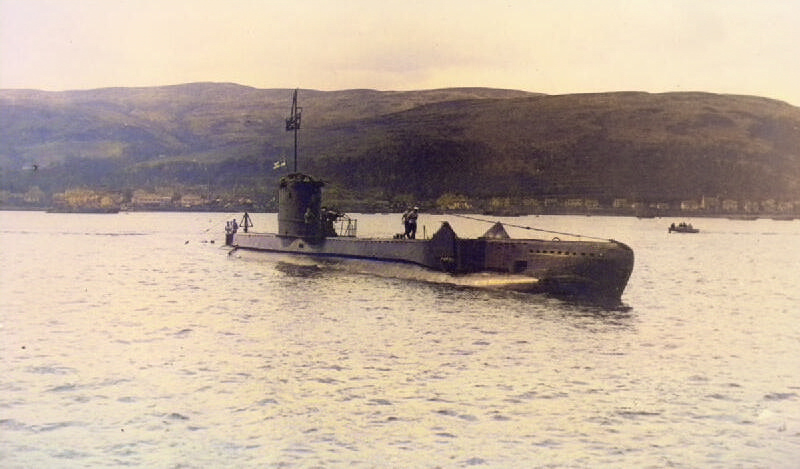
 HMS Unbeaten
HMS Unbeaten
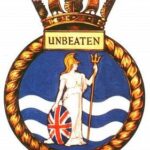 HMS Unbeaten was ordered to Vickers Armstrong, Barrow-in-Furness, laid down on 22 November 1939, launched on 9 July 1940 and commissioned on 10 November 1940, the only RN ever of that name. She served on the Mediterranean, sinking the armed sailing vessel V51/Alfa, Vichy-French merchant PLM 20, Italian submarine Guglielmotti and German U-374 but also claimed sinking two sailing vessels with gunfire on 15 July 1941 at Marsa Zuag roads off Libya. She damaged the Italian merchant Vettor Pisani on 16 March 1942. She missed the merchant Silvio Scaroni, troopship Esperia and and either Oceania or Neptunia.
HMS Unbeaten was ordered to Vickers Armstrong, Barrow-in-Furness, laid down on 22 November 1939, launched on 9 July 1940 and commissioned on 10 November 1940, the only RN ever of that name. She served on the Mediterranean, sinking the armed sailing vessel V51/Alfa, Vichy-French merchant PLM 20, Italian submarine Guglielmotti and German U-374 but also claimed sinking two sailing vessels with gunfire on 15 July 1941 at Marsa Zuag roads off Libya. She damaged the Italian merchant Vettor Pisani on 16 March 1942. She missed the merchant Silvio Scaroni, troopship Esperia and and either Oceania or Neptunia.
After a refit in Chatham, workup, she joined the 3rd Submarine Flotilla in Scotland, left from Holy Loch for her last patrol, Operation Bluestone, landing an agent near Bayona (Basque coast). She completed her patrol in the Bay of Biscay but was reported missing, believed sunk by British bomber by error on 11 November 1942, RAF Wellington of No. 172 Squadron, Coastal Command, with all hands.
 HMS Undaunted
HMS Undaunted
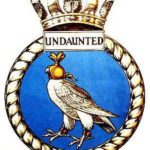 HMS Undaunted was ordered to Vickers, laid down on 2 December 1939, launched on 20 August 1940 and commissioned on 30 December 1940. She was active in the Mediterranean. On 1 May 1941 between Malta and off Tripoli, she was due to return on 11 May but was presumed lost on mines. Postwar possible scenarios includes the Italian torpedo boat Pegaso off Tripoli on the 12th and reporting a sub attack with depth charges, large patch of oil observed. However dates does not match unless Unbeaten’s skipper either decided or was forces to (tech issu) remained longer. The other possibility is the Italian torpedo boat Pleiade off Tripoli on the 13th.
HMS Undaunted was ordered to Vickers, laid down on 2 December 1939, launched on 20 August 1940 and commissioned on 30 December 1940. She was active in the Mediterranean. On 1 May 1941 between Malta and off Tripoli, she was due to return on 11 May but was presumed lost on mines. Postwar possible scenarios includes the Italian torpedo boat Pegaso off Tripoli on the 12th and reporting a sub attack with depth charges, large patch of oil observed. However dates does not match unless Unbeaten’s skipper either decided or was forces to (tech issu) remained longer. The other possibility is the Italian torpedo boat Pleiade off Tripoli on the 13th.
 HMS Union
HMS Union
HMS Union was ordered to Vickers Armstrong, laid down on 9 December 1939, launched on 1 October 1940 and commissioned on 22 February 1941. In the Mediterranean, she sank the Italian merchant Pietro Querini. But while leaving from Malta at the first hour of the morning of 14 July 1941 to intercept a convoy north of Tripoli on the 15th, she was most likely depht charged and sank on 20 July 1941 by the torpedo boat Circe, with all hands, south of Pantelleria, when attacking another convoy, she likely missed the first. She failed to return to Malta and reported overdue on 22 July.

Pietro Querini sinking, photo by a RAF aicraft from Malta. Image: IWM (C 1913)
Late Group II
Just before the war boke out, a second group of twelve units were ordered, sometimes class as the “Unique sub-class”: HMS Unique, HMS Upholder, HMS Upright and HMS Utmost had all external tubes, the others lacked it as the bulge at the bow generated a large bow wave. Depth keeping was also more difficult at periscope depth due to their rather shallow 12 ft (3.7 m) draught, which was more of a disadvantage than the six-torpedo salvo that was promoted. The sudden loss of weight in the bows as the full salvo was launched was probably the biggest issue, as the imbalance was such they invariably porpoise and break the surface. Thus, becoming immediate targets by everything in spotting range. Another issue, which was even present for the 4-torpedo of standard boats
 HMS Unique
HMS Unique
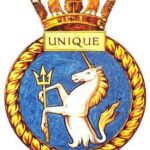 HMS Unique was laid down at Vickers Armstrong on 30 October 1939, launched on 6 June 1940 and commissioned on 27 September 1940. She served in the Mediterranean from mid 1941 under command of Captain Arthur Hezlet, sinking the freighter Fenicia and troopship Esperia, damaged the Arsia, later declared a total loss. On 5 January 1942, she attacked, but missed Littorio.
HMS Unique was laid down at Vickers Armstrong on 30 October 1939, launched on 6 June 1940 and commissioned on 27 September 1940. She served in the Mediterranean from mid 1941 under command of Captain Arthur Hezlet, sinking the freighter Fenicia and troopship Esperia, damaged the Arsia, later declared a total loss. On 5 January 1942, she attacked, but missed Littorio.
She left Holy Loch after a refit for the Bay of Biscay on 7 October 1942, left her escort off the Scillies on 9 October but was never heard of eagin. HMS Ursula was in the area on 10 October, reporting hearing underwater explosion. Germans made no claims of her sinking and she was reported overdue on 24 October 1942, now considered “sunk around the 10 October”.
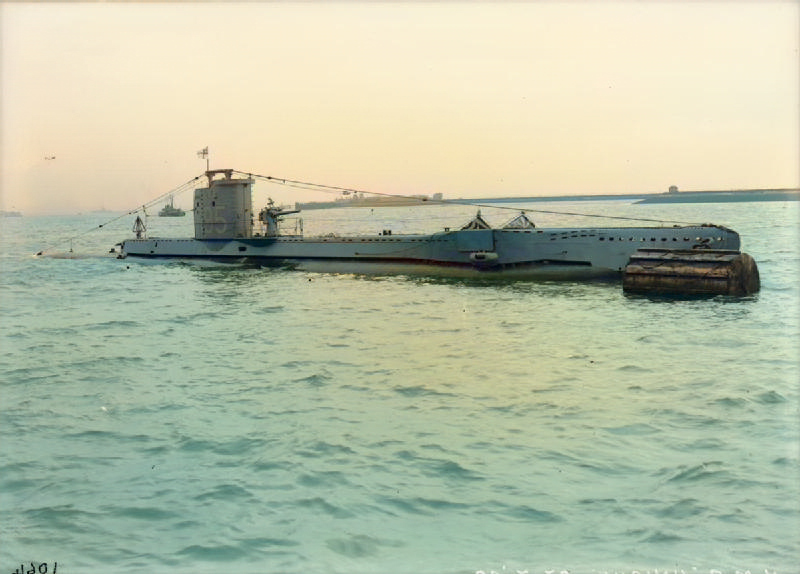
 HMS Upholder (P37)
HMS Upholder (P37)
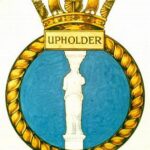 HMS Upholder was by far the most successful of the U-class and most successful of all British submarines in WW2, period. She was laid down at laid down on 30 October 1939 at Vickers, launched on 8 July 1940 and commissioned on 31 October, sent to the Mediterranean, under Malcolm David Wanklyn. She left for Malta after working up in Scotland, Holy Loch, underway on 10 December 1940. She started in the 10th submarine flotilla her first of 24 patrols from January 1941 until her loss on 14 April 1942 by the Italian torpedo boat Pegaso off Tripoli. In between, she sank four warships: The destroyer Libeccio (after the Battle of the Duisburg Convoy), two submarines (Tricheco and Ammiraglio Saint-Bon) and an auxiliary minesweeper. But also ten merchant ships, three troopships, six cargo ships, and an auxiliary transport for a total pof 93,000 GRT and the Victoria Cross to attack a well-defended convoy on 24 May 1941, torpedoing the 17,879 GRT Italian troop ship and liner Conte Rosso.
HMS Upholder was by far the most successful of the U-class and most successful of all British submarines in WW2, period. She was laid down at laid down on 30 October 1939 at Vickers, launched on 8 July 1940 and commissioned on 31 October, sent to the Mediterranean, under Malcolm David Wanklyn. She left for Malta after working up in Scotland, Holy Loch, underway on 10 December 1940. She started in the 10th submarine flotilla her first of 24 patrols from January 1941 until her loss on 14 April 1942 by the Italian torpedo boat Pegaso off Tripoli. In between, she sank four warships: The destroyer Libeccio (after the Battle of the Duisburg Convoy), two submarines (Tricheco and Ammiraglio Saint-Bon) and an auxiliary minesweeper. But also ten merchant ships, three troopships, six cargo ships, and an auxiliary transport for a total pof 93,000 GRT and the Victoria Cross to attack a well-defended convoy on 24 May 1941, torpedoing the 17,879 GRT Italian troop ship and liner Conte Rosso.
On 28 July 1941, she damaged the cruiser Giuseppe Garibaldi. On 18 September 1941 she sank two troopships, Neptunia (19,475 GRT) and Oceania (19,507 GRT) and damaged the German freighter Duisburg (7,389 GRT) in the “Duisburg convoy”. She also sank the French tanker Capitaine Damiani (4,818 GRT), Italian freighters Dandolo (4,964 GRT) and Sirio (5,223 GRT) the German freighter Arta (2,425 GRT) grounded after the battle of the Tarigo Convoy.
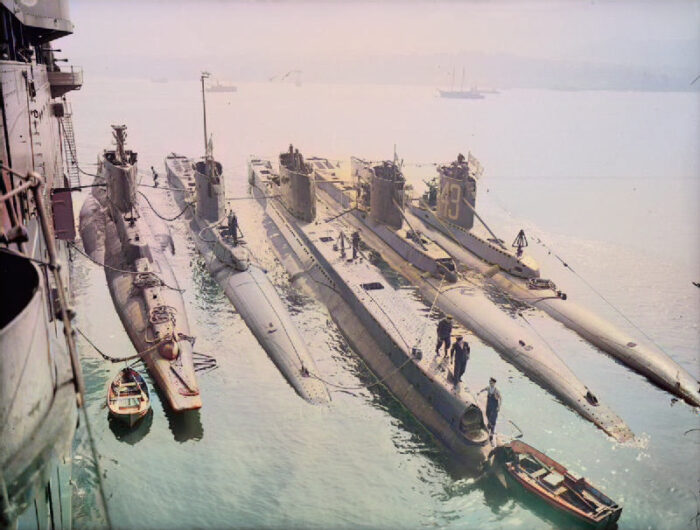
17 April 1942: HMS UPRIGHT, 2nd from left, and Flotilla berther to a repair ship of the Maidstone class, in Holy Loch. P 43 and possibly P 23 also visible.
 HMS Upright
HMS Upright
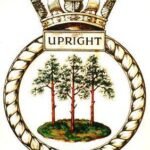 HMS Upright was laid down on 6 November 1939, launched on 21 April 1940 and commissioned on 3 September 1940. She served in the Mediterranean, sinking the Italian submarine chaser Albatros, merchants Silvia Tripcovich, Fabio Filzi, Carlo del Greco carrying previous M13/40 tanks of the XII Tank Battalion, 133rd Tank IR. to Libya. She sank the light cruiser Armando Diaz and a drydock under tow. She also damaged the transport Galilea. She missed also a floating drydock and merchant Calino and was heavily depth charged by escorts. She survived the war, sold 19 December 1945, BU March 1946.
HMS Upright was laid down on 6 November 1939, launched on 21 April 1940 and commissioned on 3 September 1940. She served in the Mediterranean, sinking the Italian submarine chaser Albatros, merchants Silvia Tripcovich, Fabio Filzi, Carlo del Greco carrying previous M13/40 tanks of the XII Tank Battalion, 133rd Tank IR. to Libya. She sank the light cruiser Armando Diaz and a drydock under tow. She also damaged the transport Galilea. She missed also a floating drydock and merchant Calino and was heavily depth charged by escorts. She survived the war, sold 19 December 1945, BU March 1946.
 HMS Urchin
HMS Urchin
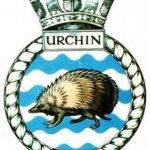 HMS Urchin was ordered to Vickers Armstrong, laid down on 9 December 1939, launched on 30 September 1940 under the pennant N97. Whe completed, she loaned to the Polish Navy from November 1941 as ORP Sokół. She was returned and renamed P97 in 1946 and was BU 1949. Her loan was decided between the two governments, with an Anglo-Polish military alliance on 18 November 1939 and 3 December 1940. Under Polish flag, captain Borys Karnicki, she was moved to Portsmouth, and started by patrolling the dangerous bay of Biscaye. Later from Malta, in the Adriatic, off northern africa and Italy, attacking even inside Naples and Pola, and the Aegean in 1944 from beirut. She ended the war in the Dundee 9th sub Flotilla, operating off Norway. Overall, she sank or damaged 19 enemy vessels for 55,000 tons total under Lieutenant Commander Karnicki, Lieutenant Commander Koziołkowski and Captain Bernas, all were awarded the Virtuti Militari.
HMS Urchin was ordered to Vickers Armstrong, laid down on 9 December 1939, launched on 30 September 1940 under the pennant N97. Whe completed, she loaned to the Polish Navy from November 1941 as ORP Sokół. She was returned and renamed P97 in 1946 and was BU 1949. Her loan was decided between the two governments, with an Anglo-Polish military alliance on 18 November 1939 and 3 December 1940. Under Polish flag, captain Borys Karnicki, she was moved to Portsmouth, and started by patrolling the dangerous bay of Biscaye. Later from Malta, in the Adriatic, off northern africa and Italy, attacking even inside Naples and Pola, and the Aegean in 1944 from beirut. She ended the war in the Dundee 9th sub Flotilla, operating off Norway. Overall, she sank or damaged 19 enemy vessels for 55,000 tons total under Lieutenant Commander Karnicki, Lieutenant Commander Koziołkowski and Captain Bernas, all were awarded the Virtuti Militari.
 HMS Urge
HMS Urge
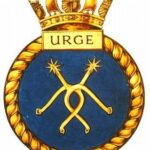 HMS Urge was laid down at Vickers on 30 October 1939, launched on 19 August 1940 and commissioned on 12 December 1940. From 1941 to 1942 was with the 10th Submarine Flotilla in Malta, damaging and sank enemy warships (Vittorio Veneto on 14 December 1941, Giovanni delle Bande Nere on 1 April 1942) and merchant vessels with also SBS and SIS special operations under Lieutenant-Commander Edward Philip Tomkinson, DSO for a totak of 20 patrols. She was sunk on 6 May 1942 (with all hands inc. passengers and one war correspondent) either by the Italian torpedo boat Pegaso on 27 April 1942, or after striking a German mine off Malta.
HMS Urge was laid down at Vickers on 30 October 1939, launched on 19 August 1940 and commissioned on 12 December 1940. From 1941 to 1942 was with the 10th Submarine Flotilla in Malta, damaging and sank enemy warships (Vittorio Veneto on 14 December 1941, Giovanni delle Bande Nere on 1 April 1942) and merchant vessels with also SBS and SIS special operations under Lieutenant-Commander Edward Philip Tomkinson, DSO for a totak of 20 patrols. She was sunk on 6 May 1942 (with all hands inc. passengers and one war correspondent) either by the Italian torpedo boat Pegaso on 27 April 1942, or after striking a German mine off Malta.
 HMS Usk
HMS Usk
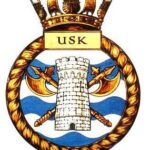 HMS Usk was laid down at Vickers on 6 November 1939, Launched on 7 June 1940 and commissioned on 11 October 1940. Sent to the Mediterranean after working up in Scotland, she sailed from Malta to patrol off the north west coast of Sicily, on 19 April 1941. She was signalled intense ASW patrols in the vicnity and to move away, but was never heard of again. She most likely struck mines in the vicinity of Cape Bon some after 25 April 1941, reported overdue on 3 May 1941. She she is assumed “mined on 3 May 1941” off Cap Bon in Tunisia.
HMS Usk was laid down at Vickers on 6 November 1939, Launched on 7 June 1940 and commissioned on 11 October 1940. Sent to the Mediterranean after working up in Scotland, she sailed from Malta to patrol off the north west coast of Sicily, on 19 April 1941. She was signalled intense ASW patrols in the vicnity and to move away, but was never heard of again. She most likely struck mines in the vicinity of Cape Bon some after 25 April 1941, reported overdue on 3 May 1941. She she is assumed “mined on 3 May 1941” off Cap Bon in Tunisia.
 HMS Utmost
HMS Utmost
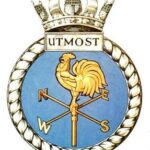 HMS Utmost was laid down on 2 November 1939 at Vickers, launched on 20 April 1940 and commissioned on 17 August 1940. In the Mediterranean, she sank the Italian merchants Capo Vita, Enrico Costa, and Frederico C., German tanker Languste, damaged the Italian merchant Manfredo Camperio. She boldly attackked later a convoy of 5 German merchants protected by 3 Italian destroyers; bagging the Heraklea, badly damaged Ruhr. In another convoy for the DAK, she missed however the German merchant Tilly L.M. Russ and Italian merchant Cadamosto, escorted by Pallade and Polluce.
HMS Utmost was laid down on 2 November 1939 at Vickers, launched on 20 April 1940 and commissioned on 17 August 1940. In the Mediterranean, she sank the Italian merchants Capo Vita, Enrico Costa, and Frederico C., German tanker Languste, damaged the Italian merchant Manfredo Camperio. She boldly attackked later a convoy of 5 German merchants protected by 3 Italian destroyers; bagging the Heraklea, badly damaged Ruhr. In another convoy for the DAK, she missed however the German merchant Tilly L.M. Russ and Italian merchant Cadamosto, escorted by Pallade and Polluce.
She finished off the Italian merchant Marigola, and became with ORP Sokół, the “terrible twins”, sink the Italian merchant Balilla but missed Fabio Filzi and Siculo, and the Italian auxiliary minelayer Barletta, but torpedoed and damaged the heavy cruiser Trieste.
Her CO Lt.Cdr. R.D. Cayley received the DSO for this and a mission, landing agents behind enemy lines. She left Malta for a last patrol in the Mediterranean in November 1942. On the 23rd she sank an enemy ship but failed to report. It was learned postwar that on 25 November while back to Malta, she was spotted and destroyed west off Sicily by the TB Groppo.
Full records on uboat.net

Crew of HMS Utmost with their “Jolly Roger” success flag
Group III (Ullswater class)
(More to come next)
11 March 1940 batch
 HMS Ullswater
HMS Ullswater
HMS Ullswater was renamed Uproar on April 1943, sold 13 February 1946, broken up
 HMS P32
HMS P32
HMS P32 was mined off Tripoli 18 August 1941 before named.
 HMS P33
HMS P33
HMS P33 was presumed lost to a mine off Tripoli, 20 August 1941, before named.
 HMS Ultimatum
HMS Ultimatum
HMS Ultimatum survived the war. Sold 23 December 1949 broken up.
 HMS Umbra
HMS Umbra
HMS Umbra survived the war, sold 9 July 1946, broken up.
 HMS P36
HMS P36
HMS P36 delivered agents to France late 1941, transferred to Mediterranean, lost before naming.
 HMS Unbending
HMS Unbending
HMS Unbending survived the war. Sold 23 December 1949, broken up 1950.
 HMS P38
HMS P38
HMS P38 was sunk by Italian ships Circe and Usodimare off Tunisia on 25 February 1942 before named.
 HMS P39
HMS P39
HMS P39 was sunk during air attack on Malta 26 March 1942 before named, raised June 1943, broken up 1954.
 HMS P41
HMS P41
HMS P41 was transferred at completion to the Royal Norwegian Navy as HNoMS Uredd. Mined, all 39 men lost, after 5 February 1943.
23 August 1940 batch
HMS Unbroken, Unison, United, Unrivalled, Unruffled, P47, P48, Unruly, Unseen, P52, Springeren, Ultor, Unshaken
(To come)
12 July 1941 batch
HMS Unsparing, Usurper, Universal, Untamed, Untiring, Varangian, Uther, Unswerving, Vandal, Upstart, Varne I, Vortex, Vox I, Vulpine
(To come)
Succession: V class
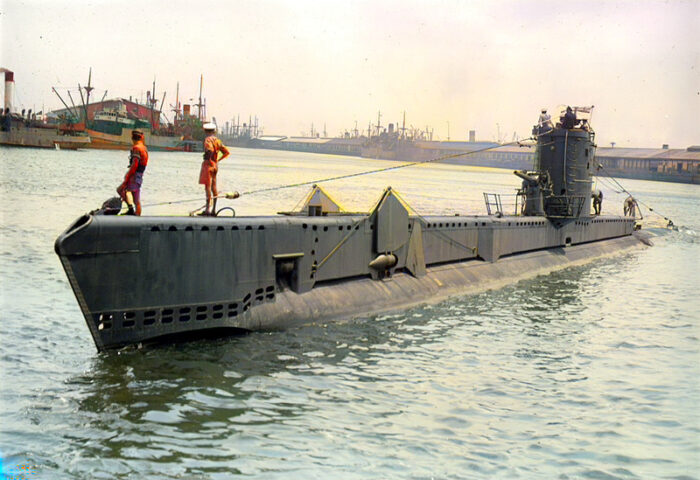
The V-class, officially the “U class, long hull”, was a late war ultimate variant of the wartime U-class, the third pillar of the British underwater Forces in world war two, especially active in the Mediterranean. These were a development of the 1937 Undine and 1940 “short hull” class, boosted by wartime experience. This class, laid down in 1942-43 and completed in 1943-45, had its stern lengthened to give an easier angle of approach of water to the propellers in order to reduce noise, with a further fining of the bows. The hull had welded framing and the riveted plating was increased from half to three-quarter of an inch, so that the operational depth limit was increased to 300ft. None was sunk in action, Some were transferred in wartime, but most were sold postwar as surplus, to Norway, Greece, France and Denmark.
Read More/Src
Books
Brown, D. K. (2012) [2000]. Nelson to Vanguard (hbk. repr. Seaforth Publishing (Pen & Sword) ed.). Barnsley: Chatham Publishing.
Chesneau, Roger (1992) [1980]. Gardiner, Robert (ed.). Conway’s All the World’s Fighting Ships 1922–46 (3rd ed.). London: Conway Maritime Press.
Colledge, J. J.; Wardlow, B. (2006) [1969]. Ships of the Royal Navy: The Complete Record of all Fighting Ships of the Royal Navy. Chatham.
McCartney, I. (2006). British Submarines 1939–45. New Vanguard (No. 159). Oxford: Osprey.
Pol, E. van den (1989). “Aspects of Submarines – Part I: Some Notes on Development”. Schip en Werf. Vol. 56.
Walters, Derek (2004). The History of the British ‘U’ Class Submarine. Barnsley: Pen & Sword.
Friedman, N. (2019). British Submarines in two World Wars (e-Pub ed.). Barnsley: Seaforth (Pen & Sword).
Hutchinson, Robert (2001). Submarines, War Beneath The Waves, From 1776 To The Present Day. London: HarperCollins.
Links
rnsubs.co.uk/ u-class.html
on uboat.net/
on web.archive.org/ home.cogeco.ca
wikipedia.org British_U-class_submarine
wikipedia.org/ V-class_submarine
archive.org/ Janessubmarines
navweaps.com 3-in 45 mk1
navweaps.com/ Brit Torps. ww2
Model Kits
all kits on scalemates.com: 1:400, 1:350, 1:700

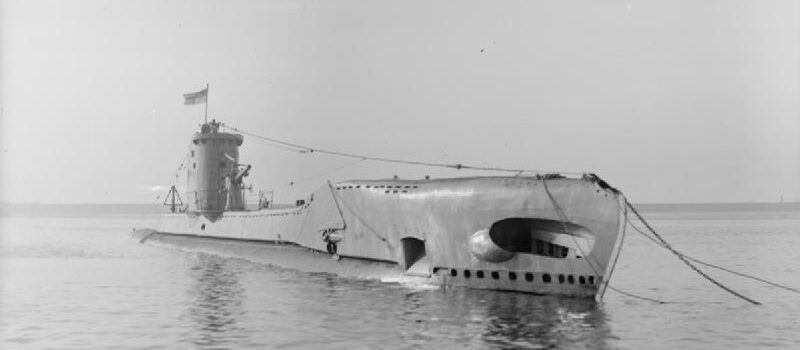
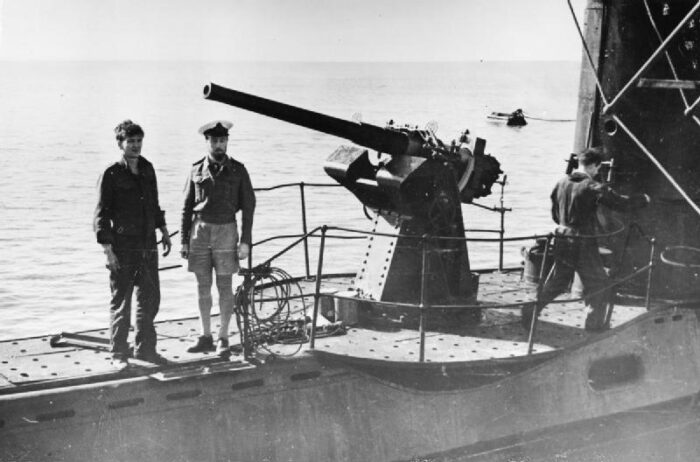

 Latest Facebook Entry -
Latest Facebook Entry -  X(Tweeter) Naval Encyclopedia's deck archive
X(Tweeter) Naval Encyclopedia's deck archive Instagram (@navalencyc)
Instagram (@navalencyc)





 French Navy
French Navy Royal Navy
Royal Navy Russian Navy
Russian Navy Armada Espanola
Armada Espanola Austrian Navy
Austrian Navy K.u.K. Kriegsmarine
K.u.K. Kriegsmarine Dansk Marine
Dansk Marine Nautiko Hellenon
Nautiko Hellenon Koninklije Marine 1870
Koninklije Marine 1870 Marinha do Brasil
Marinha do Brasil Osmanlı Donanması
Osmanlı Donanması Marina Do Peru
Marina Do Peru Marinha do Portugal
Marinha do Portugal Regia Marina 1870
Regia Marina 1870 Nihhon Kaigun 1870
Nihhon Kaigun 1870 Preußische Marine 1870
Preußische Marine 1870 Russkiy Flot 1870
Russkiy Flot 1870 Svenska marinen
Svenska marinen Søværnet
Søværnet Union Navy
Union Navy Confederate Navy
Confederate Navy Armada de Argentina
Armada de Argentina Imperial Chinese Navy
Imperial Chinese Navy Marinha do Portugal
Marinha do Portugal Mexico
Mexico Kaiserliche Marine
Kaiserliche Marine 1898 US Navy
1898 US Navy Sovietskiy Flot
Sovietskiy Flot Royal Canadian Navy
Royal Canadian Navy Royal Australian Navy
Royal Australian Navy RNZN Fleet
RNZN Fleet Chinese Navy 1937
Chinese Navy 1937 Kriegsmarine
Kriegsmarine Chilean Navy
Chilean Navy Danish Navy
Danish Navy Finnish Navy
Finnish Navy Hellenic Navy
Hellenic Navy Polish Navy
Polish Navy Romanian Navy
Romanian Navy Turkish Navy
Turkish Navy Royal Yugoslav Navy
Royal Yugoslav Navy Royal Thai Navy
Royal Thai Navy Minor Navies
Minor Navies Albania
Albania Austria
Austria Belgium
Belgium Columbia
Columbia Costa Rica
Costa Rica Cuba
Cuba Czechoslovakia
Czechoslovakia Dominican Republic
Dominican Republic Haiti
Haiti Hungary
Hungary Honduras
Honduras Estonia
Estonia Iceland
Iceland Eire
Eire Equador
Equador Iran
Iran Iraq
Iraq Latvia
Latvia Liberia
Liberia Lithuania
Lithuania Mandchukuo
Mandchukuo Morocco
Morocco Nicaragua
Nicaragua Persia
Persia San Salvador
San Salvador Sarawak
Sarawak Uruguay
Uruguay Venezuela
Venezuela Zanzibar
Zanzibar Warsaw Pact Navies
Warsaw Pact Navies Bulgaria
Bulgaria Hungary
Hungary

 Bundesmarine
Bundesmarine Dutch Navy
Dutch Navy Hellenic Navy
Hellenic Navy Marina Militare
Marina Militare Yugoslav Navy
Yugoslav Navy Chinese Navy
Chinese Navy Indian Navy
Indian Navy Indonesian Navy
Indonesian Navy JMSDF
JMSDF North Korean Navy
North Korean Navy Pakistani Navy
Pakistani Navy Philippines Navy
Philippines Navy ROKN
ROKN Rep. of Singapore Navy
Rep. of Singapore Navy Taiwanese Navy
Taiwanese Navy IDF Navy
IDF Navy Saudi Navy
Saudi Navy Royal New Zealand Navy
Royal New Zealand Navy Egyptian Navy
Egyptian Navy South African Navy
South African Navy






























 Ukrainian Navy
Ukrainian Navy dbodesign
dbodesign